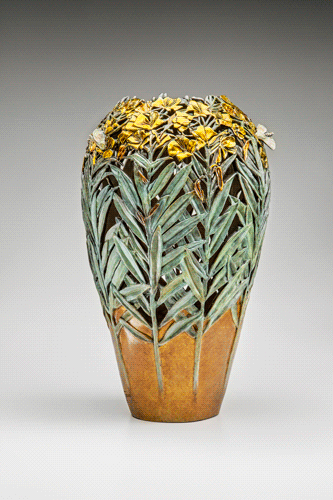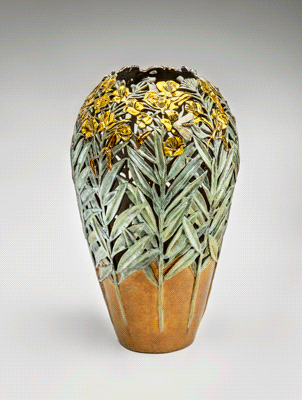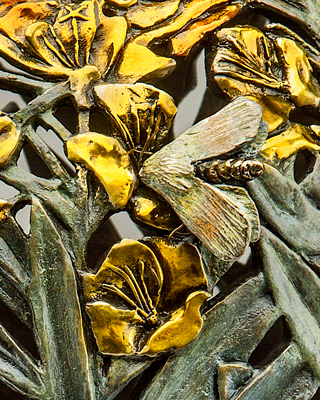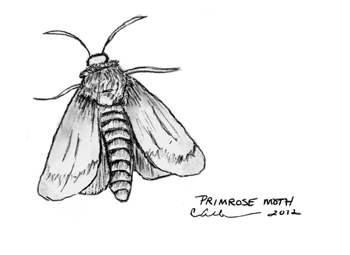edition of 29
16″ h x 9.5″ w

(The Evening- Primrose)
akin to the glassy yellow eyes of the mystical owl
golden petals spill into the sapphire twilight
as glowing, radiant stars of beaming light
sprinkled with tiny golden crosses
the pink and yellow primrose moth
flutters to its host beset in
a flooding, welcome banquet
of nectar and pollen
its long, thin, curling tongue dips
deep – deep into the throat
swelling itself with the rich
sweet, flowing nectar
lemon scented, the primrose stems, petals, blooms
generously feed the winged ones
and the two-legged ones
through her rich, potent pouch of medicine
 as morning dawns
as morning dawns
her spent, pink-orange blossoms lazily droop
in a blanket of incognito for her guests
colors fusing as it warmly shrouds
her seeds are sprinkled
by the ever potent Wind
gently scattering them about
in a perfect rhythm of renewal
as we settle into slumber
in the stillness of twilight
indeed the world is fully awake
with a radiant internal Light
opening us, not unlike the Primrose Moth
to our blanket of Love
to our natural womb
and our utter nourishment
in the quiet, seemingly dark hours
perfect mystery awakens
to the feeding – the blooming
the Light of the radiant Twilight Stars
TWILIGHT STARS was included in the Tempe Center of the Arts, 2015/16 Exhibition Green & Gray; it earned the FIRST PLACE IN SCULPTURE AWARD at the Gilcrease Museum Collector’s reserve in 2015; and exhibited at the Mesa Contemporary Museum of Art; 39th Annual Crafts Exhibition in 2018. In 2020 it earned the Award of Distinguished Achievement in Sculpture at the Booth Western Art Museum, “Making Their Mark: American Women Artists”.

Inspiration
“The night butterfly which shrivels the leaves on which it settles, the moth is the constant symbol of the soul seeking the godhead and consumed by a mystical love, attracted like the insect fluttering round the candle until it burns its wings. The theme is a thread which runs through Persian mystical poetry and the moth becomes the symbol of humanity in the chilly darkness, yearning for wings to take flight towards the heights of divine love.” P 676; Dictionary of Symbols; Jean Chevalier and Alain Gheerbrant; 1996
Indeed, the dance between the Primrose Moth and the Evening-Primrose plant resembles a mystical pilgrimage. As a glowing wild herb; evening-primrose grows erect – straight for the heavens – as she holds her spent blooms in a jeweled display of pinks and oranges. She is a night bloomer – opening her blossoms in the twilight and closing them again in the morning. This habit places evening-primrose in the owlet family – blooming – in the darkness of the night. We human beings may well give too little attention to the depths of renewal occurring during our own evening slumber. It is in this time – often filled with dramatic dreams – that we are subconsciously renewed and nudged along our journey physically, emotionally and spiritually. It is during this time that we rhythmically breathe without any effort on our part. As we slumber, we are grown – nourished – effortlessly bloomed during the darkest hours of our day, as again nature inspires us to follow her perfect map.
Beautifully partnered, the primrose moth and the evening-primrose plant are intertwined together – the blooms providing the soft bed for the moth to slumber incognito in her petals; as she camouflages her in her wilting blooms. How sweet is this? And how perfectly is nature designed to allow for such a lovely union? This nightly performance is done without effort – the moth is simply and naturally drawn to the evening-primrose, nourished and held. We too are naturally inclined toward a greater force than ourselves – a Mother, if you will, with a welcome nest of nourishment and contentment.
Although the moth lays her eggs on the primrose, which as they hatch, eat the primrose plant, little damage is experienced by the primrose. It’s a rich plate of generosity, hospitality and mothering. The night flying moth symbolically is the soul seeking the godhead – seeking deeper wisdom akin to the owl and the goddess Athena. The wisdom is found in this perfect union of the two. “Do not be afraid of the dark” we advise our young ones. Instead perhaps, we might invite them to appreciate this holy time of effortless mystery, beauty and blooming….perhaps we might encourage their own yearning toward Home through their slumber as well as in wakeful moments. And, perhaps we might remind them and ourselves of the utter trust we experience every night as we are effortlessly breathed through the quiet night hours.
The seeds of the evening-primrose are dispersed by the wind – the Wind. Again, this magical time of night – the wisdom flowing uninhibited – allows for the wind, or Spirit, to take over the job of dispersing. Much, if not all, in our lives is dispersed by Spirit without any need of our assistance save surrendering to its Truth while simply doing whatever is before us at any given moment – with utter trust, integrity and love.
Twilight Stars, with nine stems of erect growing evening-primrose (reaching straight toward the heavens) gives home as well to three (a divinely creative number) evening primrose moths. Two of the negative spaces (the open or cut-out areas) are shaped as silhouettes of the owl – two representing the duality of dark and light/day and night. The companion poetry holds nine stanzas – mirroring the nine stems of blooms and the beautiful number of completion. The duality held, in perfect union, symbolizes our natural yearning toward Home – our place of completion. The edition size is 29 – 3 (primrose moths) x 9 stems of evening primrose + 2 owls. The “2” represents duality coupled with the “9” of completion – Home.
Evening Primrose Facts

(Onagraceae Family/ Oenothera Biennis)
- A very well represented wild biennial herb in North America
- Erect stem growing 3- 5’ tall
- In a botanical family all of its own – neither a rose nor a primrose, nor closely related to either
- The seeds are dispersed by the wind
- Blooms open in the early evening very quickly and close again in the morning hours
- It is pollinated primarily by the sphinx moth family and the primrose moth
- It has a very potent lemony fragrance
- Leaves are 3-6” long and blooms are 1- 2.5” wide
- Blooms are shades of bright yellow (younger ones lighter) and spent blooms droop on the plant in shades of pink to orange
- 4- 10 stamen; with a single pistil and sepals often turning downward
- Blooms have four petals with a profoundly cross shaped stigma
- The entire plant is edible and is widely used for its valuable medicinal qualities in oils, teas, and powders
- Flowering begins in July and continues as late as October
- *A recent study by the National Science Foundation revealed “hard evidence of evolution: a five year study [using the Evening Primrose] shows that plants may quickly lose important traits through evolution soon after insects are removed from the environment.”
References:
www.plants.usda.gov/plantguide/pdf/cs_oebi.pdf
www.luontoportti.com/suomi/en/kukkakasvit/evening-primrose
www.riwps.org/eveningprimrose.htm
http://bugguide.net/node/view/38844
www.altnature.com/gallery/Evening_Primrose.htm
*www.nsf.gov/news/news_summ.jsp?cntn_id+125636
The Secrets of Wildflowers, by Jack Sanders 2003
And, for information on how to grow Evening Primrose, please visit:
https://happydiyhome.com/primrose-flower/
Primrose Moth Facts

(Schinia Florida)
- It is in the owlet family
- The moth is pink with a narrow yellow band at the bottom of wings and on head
- Proboscis (a hallow straw-like tongue) is about half the length of its body used for sucking nectar
- It is often found in the morning hours buried deep into a closed primrose bloom or even partially into a spent bloom nearly obscured as its colors blend so well with that of the evening-primrose blooms
- They suck nectar from evening primrose and lay eggs upon it
- There appear to be various opinions about its pollination qualities however by its frequent visitation it is generally assumed to pollinate, even if moderately so, as it moves from bloom to bloom
- Butterflies and moths belong to the same insect order, Lepidoptera
- Primrose moth is approximately 2.5 – 3.6 cm in wing span
- A night-flying moth
References:
www.butterfliesandmoths.org/species/Schinia-florida
http://en.wikipedia.org/wiki/File:Primrose_Moth.jpg
http://northernwoodlands.org/outside_story/article/primrose_moth_and_its_lovely_hangout/
http://bugguide.net/node/view/5928
http://peabody.research.yale.edu/jls/pdfs/1970s/1976/1976-30%284%29301-Handel.pdf
http://pnwmoths.biol.wwu.edu/browse/family-noctuidae/subfamily-heliothinae/schinia/schinia-florida/
Growing the Evening Primrose: https://happydiyhome.com/primrose-flower/
